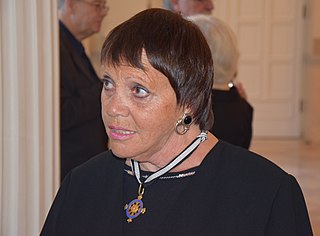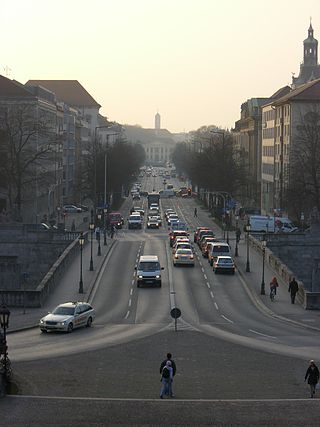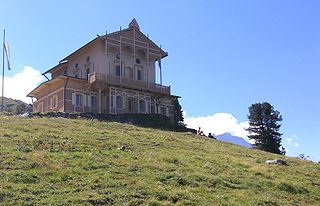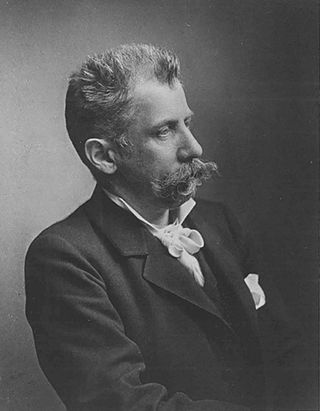This article needs additional citations for verification .(June 2021) |

The Strauss Villa is the home of the German composer Richard Strauss in the Upper Bavarian town of Garmisch-Partenkirchen.
This article needs additional citations for verification .(June 2021) |

The Strauss Villa is the home of the German composer Richard Strauss in the Upper Bavarian town of Garmisch-Partenkirchen.
Between 1907 and 1908, the Art Nouveau architect Emanuel von Seidl built the villa on the property located at Zoeppritzstraße 42 in Garmisch. Richard Strauss preferred what was then Garmisch to what used to be the neighboring town of Partenkirchen because of its cooler weather. The family used the house as a summer retreat from 1908 and later as a permanent residence. The two-storey building was created by von Seidl as a hipped roof building with a plastered structure and implementing the requirements specified by Richard and Pauline Strauss. The structure is listed building number D-1-80-117-262 under the Monument Protection Act of October 1, 1973. [1]
Today, the villa remains a private residence maintained by the Strauss family and was the home of Strauss' grandson Christian until his death in February 2020. [2] The study houses historical works as well as German classics. The first floor bedrooms today house an archive. The room where Strauss died now serves as a memorial. [1]

Richard Georg Strauss was a German composer and conductor best known for his tone poems and operas. Considered a leading composer of the late Romantic and early modern eras, he has been described as a successor of Richard Wagner and Franz Liszt. Along with Gustav Mahler, he represents the late flowering of German Romanticism, in which pioneering subtleties of orchestration are combined with an advanced harmonic style.
Bad Tölz-Wolfratshausen is a Landkreis (district) in Bavaria, Germany. It is bounded by Austria and the districts of Garmisch-Partenkirchen, Weilheim-Schongau, Starnberg, Munich and Miesbach.
Garmisch-Partenkirchen is a Landkreis (district) in Bavaria, Germany. It is bounded by the districts of Ostallgäu, Weilheim-Schongau and Bad Tölz-Wolfratshausen, and by the Austrian state of Tyrol.

Garmisch-Partenkirchen is an Alpine ski town in Bavaria, southern Germany. It is the seat of government of the district of Garmisch-Partenkirchen, in the Oberbayern region, which borders Austria. Nearby is Germany's highest mountain, Zugspitze, at 2,962 metres (9,718 ft) above sea level.

The Walhalla is a hall of fame that honours laudable and distinguished people in German history – "politicians, sovereigns, scientists and artists of the German tongue"; thus the celebrities honoured are drawn from Greater Germany, a wider area than today's Germany, and even as far away as Britain in the case of several Anglo-Saxon figures. The hall is a neo-classical building above the Danube River, in Donaustauf, east of Regensburg in Bavaria.

Murnau am Staffelsee is a market town in the district of Garmisch-Partenkirchen, in the Oberbayern region of Bavaria, Germany.

Brigitte Fassbaender, is a German mezzo-soprano opera singer and a stage director. From 1999 to 2012 she was intendant of the Tyrolean State Theatre in Innsbruck, Austria. She holds the title Kammersängerin from the Bavarian State Opera in Munich and the Vienna Staatsoper.

Schloss Elmau is a four-story castle and national monument with hipped roof, tower and porch, situated between Garmisch-Partenkirchen and Mittenwald in a sanctuary of the Bavarian Alps, Germany. It lies at the foot of the Wetterstein mountains in a Naturschutzgebiet, belonging to the Krün municipality. It was built by philosopher and theologian Johannes Müller and architect Carl Sattler between 1914 and 1916.

Pauline Maria de Ahna (also known as Pauline Strauss was a German operatic soprano and the wife of composer Richard Strauss. Her singing career was closely tied to her husband's career as a conductor and composer. From 1890 until 1894 she was committed to the Staatskapelle Weimar and from 1894 until 1897 she was committed to the Bavarian State Opera, during which times her husband was the principal conductor of those theaters. She also sang with her husband conducting at the Bayreuth Festival and in the world premiere of his first opera Guntram. Other houses at which performed included the Berlin State Opera, La Monnaie, and the Liceu. Her repertoire included leading roles in the operas of Beethoven, Humperdinck, Mozart, von Weber, and Wagner. After she gave birth to their son Franz Strauss in 1897 she retired from the opera stage. She thereafter continued to periodically perform in concerts of her husband's music, particularly Lieder. Strauss credited her as his muse for many of his compositions, including the title role in Salome, the Countess Madeleine in Capriccio, and the Four Last Songs among others.
Olympische Hymne is a composition for orchestra and mixed chorus by Richard Strauss.

The Prinzregentenstraße in Munich is one of four royal avenues and runs parallel to Maximilianstraße and begins at Prinz-Carl-Palais, in the northeastern part of the Old Town. The avenue was constructed from 1891 onwards as a prime address for the middle-class during the reign of Luitpold, Prince Regent of Bavaria and is named in his honour. The square in the eastern part of the street is named Prinzregentenplatz.

The King's House on Schachen is a small villa (Schlösschen) at Schachen, Wetterstein Formation, about 10 km south of Garmisch-Partenkirchen, Bavaria, Germany, built by Ludwig II of Bavaria. The castle was constructed between 1869 and 1872.

The Munich–Garmisch-Partenkirchen railway is a single track, electrified main line railway in the southern part of the German state of Bavaria. It runs from Munich via Starnberg and Murnau to Garmisch-Partenkirchen. The first part of it was opened in 1854 and is one of the oldest lines in Germany.

The Partnach Gorge is a deep gorge that has been incised by a mountain stream, the Partnach, in the Reintal valley near the south German town of Garmisch-Partenkirchen. The gorge is 702 metres (2,303 ft) long and, in places, over 80 metres (260 ft) deep. It was designated a natural monument in 1912.

The Mittenwald Railway, popularly known as the Karwendelbahn, is a railway line in the Alps in Austria and Germany. It connects Innsbruck via Seefeld and Mittenwald to Garmisch-Partenkirchen.

Weilheim (Oberbay) station is the station of the Bavarian district town of Weilheim in Oberbayern. It is a crossing station on the Munich–Garmisch-Partenkirchen railway, the Ammersee Railway from Mering and the Weilheim–Peißenberg railway. It is classified by Deutsche Bahn as a category 4 station and has five platform tracks. It is served by about 100 trains daily operated by Deutsche Bahn and Bayerische Regiobahn (BRB).

Gabriel von Seidl was a German architect and a representative of the historicist style of architecture.

The ruins of Werdenfels Castle stand about 80 metres above the Loisach valley between Garmisch and Farchant in the county of Garmisch-Partenkirchen in Upper Bavaria. The spur castle was used until 1632 as the administrative centre of the County of Werdenfels, but began to fall into disrepair thereafter.

The Richard-Wagner-Straße is a street in the Bavarian state capital Munich. It is named after the composer Richard Wagner (1813-1883), who lived in the vicinity of Brienner Straße 37 in 1864-65.
Franz Klarwein was a German operatic lyric tenor and later character tenor. He was a member of the Bavarian State Opera from 1942 to 1977 and also appeared at international opera houses and festivals, especially in roles by Richard Strauss. Scheduled to sing in the 1944 world premiere of Die Liebe der Danae at the Salzburg Festival, which did not take place, he performed in both the English premiere at the Royal Opera House in London and the Swiss premiere at the Opernhaus Zürich. He sang in world premieres such as Capriccio in 1942, Hindemith's Die Harmonie der Welt in 1957, and Ján Cikker's Das Spiel von Liebe und Tod in 1969.